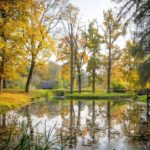Jezupova (Juzefova) Manor Park was built in the 19th century in Dutch style and until the end of the 19th century there was also a manor here. Nawadays only a small part of the park, which contains more than 100 different species of plants, has survived. Initial name of the Park was “Hofzumberg” that in translation from German language means “house on mountain (hill)”. In the end of the 18th century the Park was renamed to Jezupova Park. The manor house was built by the owner, B. Shahno, as a model of the castle seen in the vicinity of Paris. Currently, only the foundations of the manor house can be seen. The former baron horse stables is the only building which survived to this day.
Majority of tree species in this park, like in other manor parks, are very special. The unique atmosphere of the Jezupova Park is made up of Swiss pine, Cork-barked elm and white poplar. The rare snail – Isognomostoma isognomostomos is found in the Park, and the surroundings are the only place in Latvia where this species lives. From Jezupova Park flows a spring, the water of which supposedly has healing property.
In Southeastern part of the Park there is 82cm long, 46cm wide and 10cm high grey boulder, on the flat surface of which there is carved cross. According to narration of the nanny of Bogdans Shahno, the last Count of the manor, a tragic incident of 1922 is connected with the cross stone. Two youths (manor’s maid and a stableman) were preparing for the wedding. But the old Count desired the maid and didn’t allow her to wed. The maid put on the wedding dress and jumped out of the window, thus putting an end to herself. The groom couldn’t undergo the death of his lass and hanged himself in the Park. Manor’s people in that place located a boulder and carved a cross in it.

